Issues in Audit Practice
VerifiedAdded on 2023/06/03
|13
|2512
|324
AI Summary
The report highlights material items identified from the trial balance and income statement of Chamoisee Enterprise. It establishes the materiality level for the entity and determines the assertion associated with the items. Audit procedures are suggested for each identified material item.
Contribute Materials
Your contribution can guide someone’s learning journey. Share your
documents today.

Running head: ISSUES IN AUDIT PRACTICE
Issues in audit practice
Name of the student
Name of the university
Author note
Issues in audit practice
Name of the student
Name of the university
Author note
Secure Best Marks with AI Grader
Need help grading? Try our AI Grader for instant feedback on your assignments.
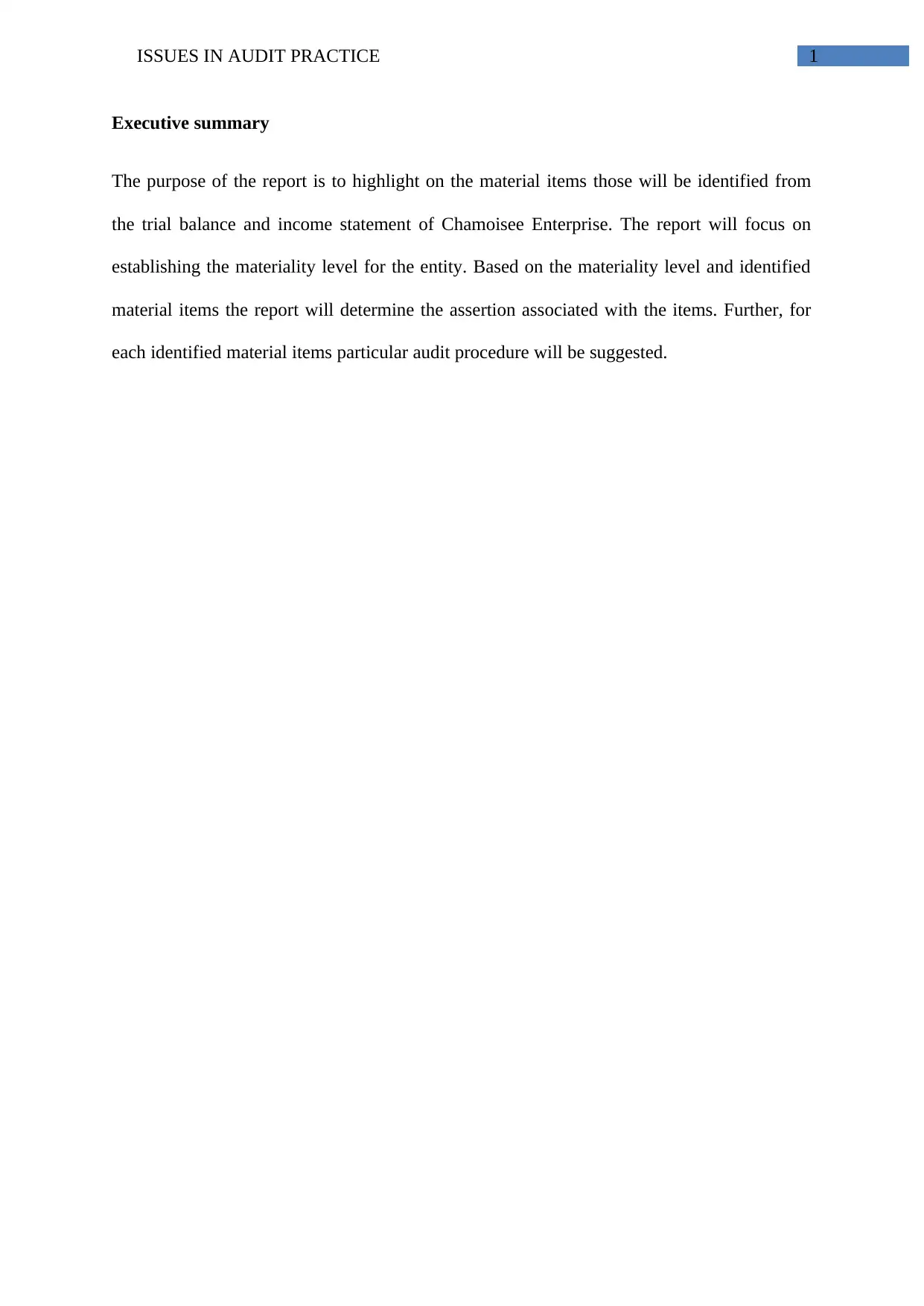
1ISSUES IN AUDIT PRACTICE
Executive summary
The purpose of the report is to highlight on the material items those will be identified from
the trial balance and income statement of Chamoisee Enterprise. The report will focus on
establishing the materiality level for the entity. Based on the materiality level and identified
material items the report will determine the assertion associated with the items. Further, for
each identified material items particular audit procedure will be suggested.
Executive summary
The purpose of the report is to highlight on the material items those will be identified from
the trial balance and income statement of Chamoisee Enterprise. The report will focus on
establishing the materiality level for the entity. Based on the materiality level and identified
material items the report will determine the assertion associated with the items. Further, for
each identified material items particular audit procedure will be suggested.
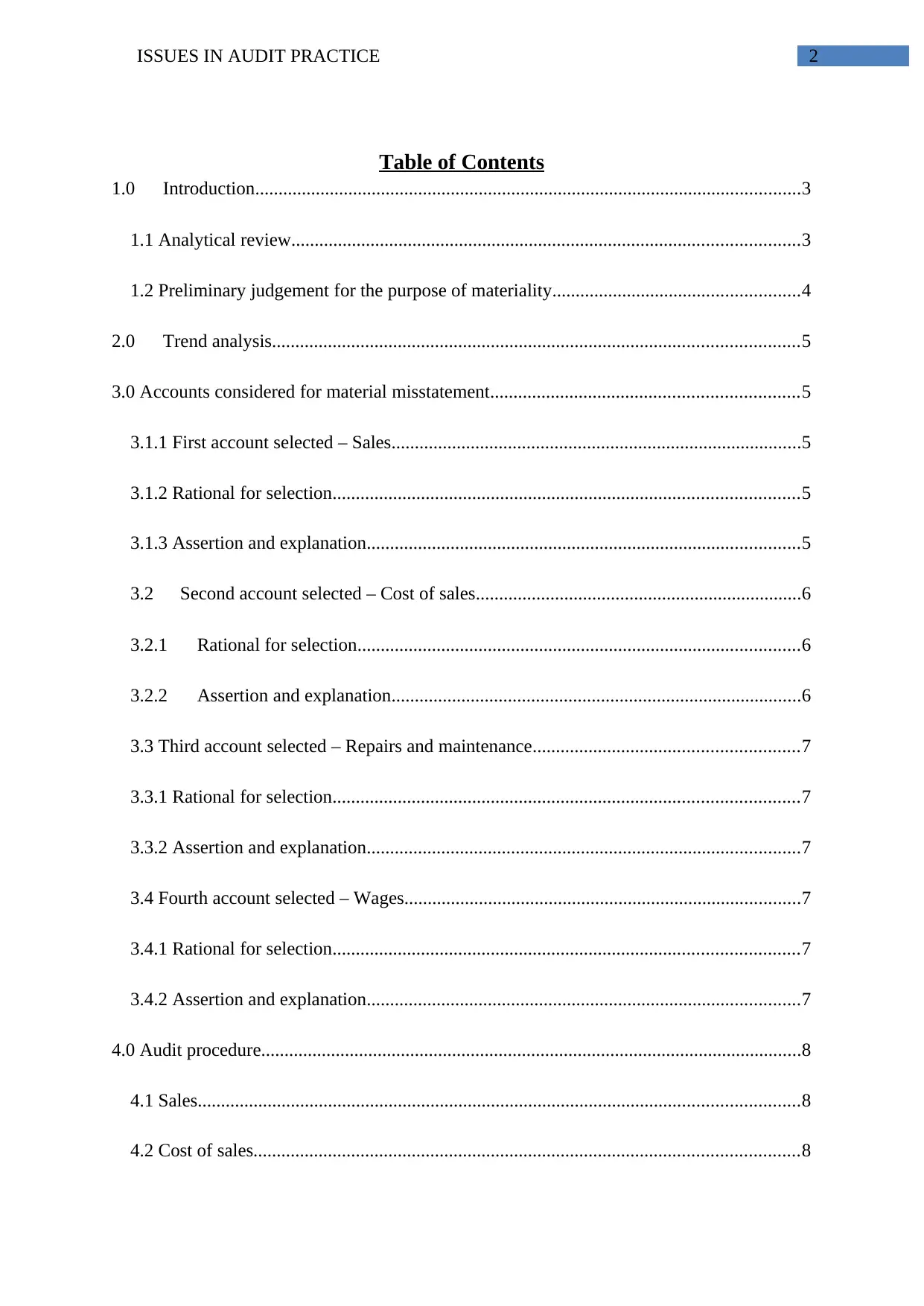
2ISSUES IN AUDIT PRACTICE
Table of Contents
1.0 Introduction.....................................................................................................................3
1.1 Analytical review.............................................................................................................3
1.2 Preliminary judgement for the purpose of materiality.....................................................4
2.0 Trend analysis.................................................................................................................5
3.0 Accounts considered for material misstatement..................................................................5
3.1.1 First account selected – Sales........................................................................................5
3.1.2 Rational for selection....................................................................................................5
3.1.3 Assertion and explanation.............................................................................................5
3.2 Second account selected – Cost of sales......................................................................6
3.2.1 Rational for selection...............................................................................................6
3.2.2 Assertion and explanation........................................................................................6
3.3 Third account selected – Repairs and maintenance.........................................................7
3.3.1 Rational for selection....................................................................................................7
3.3.2 Assertion and explanation.............................................................................................7
3.4 Fourth account selected – Wages.....................................................................................7
3.4.1 Rational for selection....................................................................................................7
3.4.2 Assertion and explanation.............................................................................................7
4.0 Audit procedure....................................................................................................................8
4.1 Sales.................................................................................................................................8
4.2 Cost of sales.....................................................................................................................8
Table of Contents
1.0 Introduction.....................................................................................................................3
1.1 Analytical review.............................................................................................................3
1.2 Preliminary judgement for the purpose of materiality.....................................................4
2.0 Trend analysis.................................................................................................................5
3.0 Accounts considered for material misstatement..................................................................5
3.1.1 First account selected – Sales........................................................................................5
3.1.2 Rational for selection....................................................................................................5
3.1.3 Assertion and explanation.............................................................................................5
3.2 Second account selected – Cost of sales......................................................................6
3.2.1 Rational for selection...............................................................................................6
3.2.2 Assertion and explanation........................................................................................6
3.3 Third account selected – Repairs and maintenance.........................................................7
3.3.1 Rational for selection....................................................................................................7
3.3.2 Assertion and explanation.............................................................................................7
3.4 Fourth account selected – Wages.....................................................................................7
3.4.1 Rational for selection....................................................................................................7
3.4.2 Assertion and explanation.............................................................................................7
4.0 Audit procedure....................................................................................................................8
4.1 Sales.................................................................................................................................8
4.2 Cost of sales.....................................................................................................................8
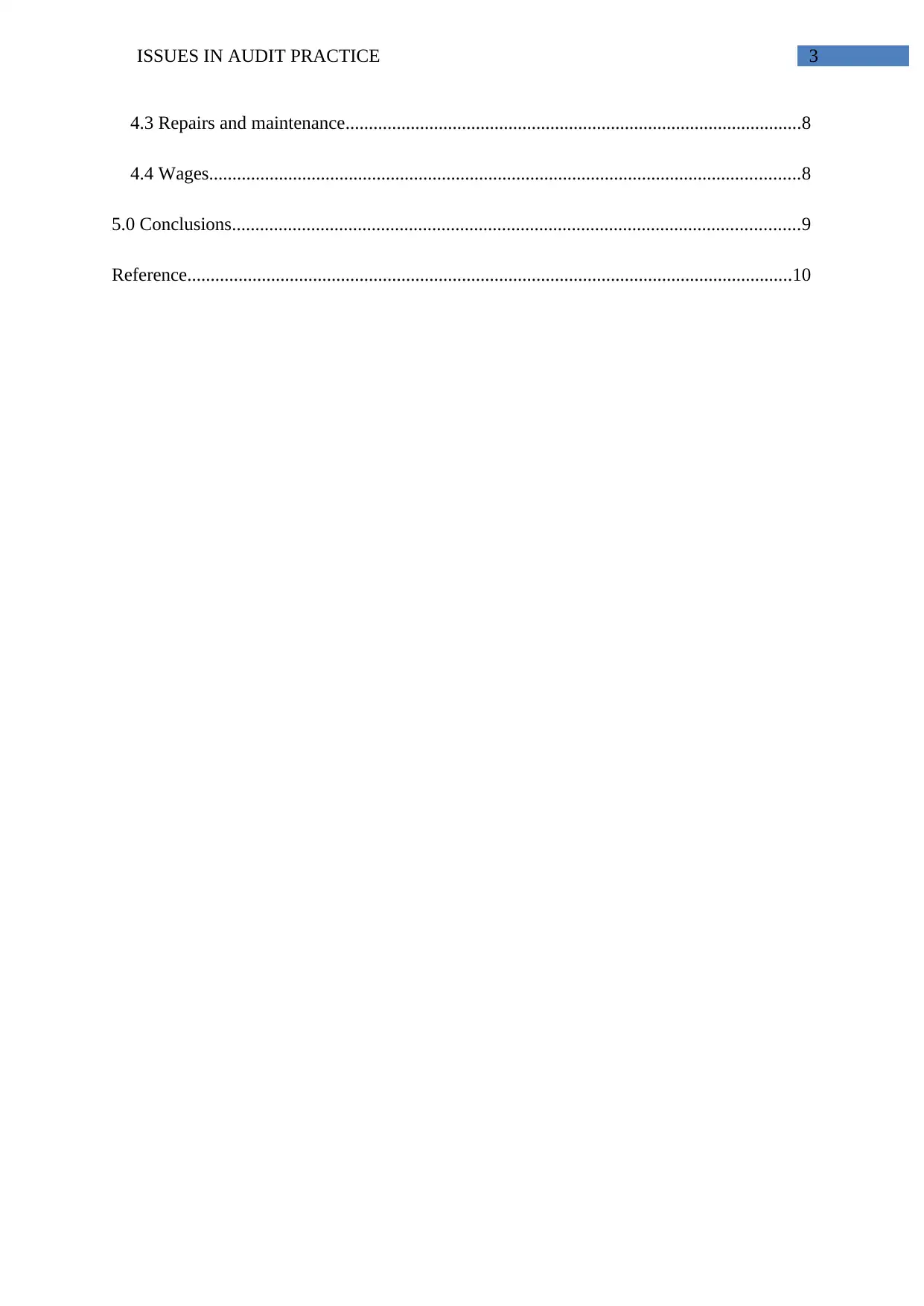
3ISSUES IN AUDIT PRACTICE
4.3 Repairs and maintenance..................................................................................................8
4.4 Wages...............................................................................................................................8
5.0 Conclusions..........................................................................................................................9
Reference..................................................................................................................................10
4.3 Repairs and maintenance..................................................................................................8
4.4 Wages...............................................................................................................................8
5.0 Conclusions..........................................................................................................................9
Reference..................................................................................................................................10
Secure Best Marks with AI Grader
Need help grading? Try our AI Grader for instant feedback on your assignments.
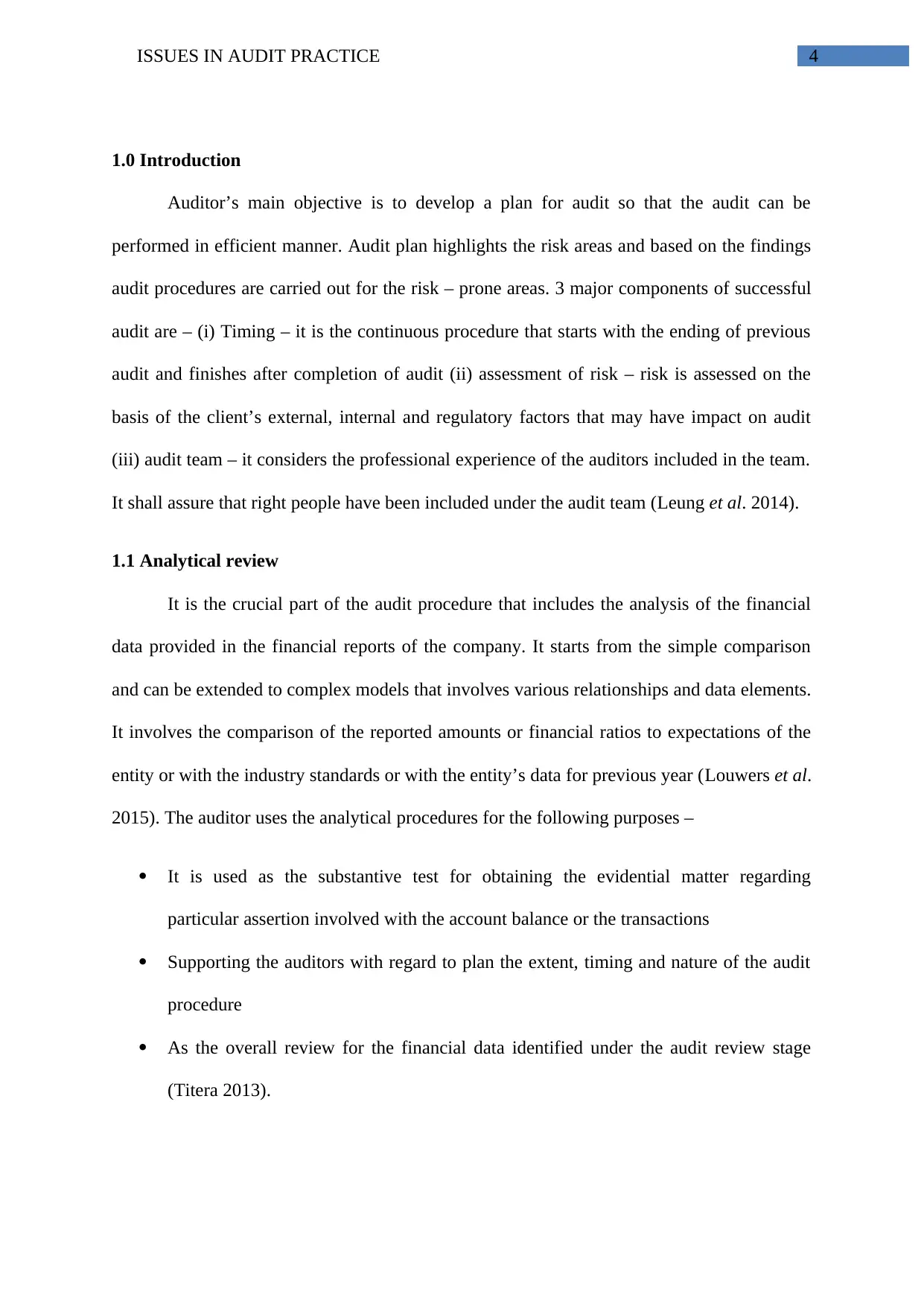
4ISSUES IN AUDIT PRACTICE
1.0 Introduction
Auditor’s main objective is to develop a plan for audit so that the audit can be
performed in efficient manner. Audit plan highlights the risk areas and based on the findings
audit procedures are carried out for the risk – prone areas. 3 major components of successful
audit are – (i) Timing – it is the continuous procedure that starts with the ending of previous
audit and finishes after completion of audit (ii) assessment of risk – risk is assessed on the
basis of the client’s external, internal and regulatory factors that may have impact on audit
(iii) audit team – it considers the professional experience of the auditors included in the team.
It shall assure that right people have been included under the audit team (Leung et al. 2014).
1.1 Analytical review
It is the crucial part of the audit procedure that includes the analysis of the financial
data provided in the financial reports of the company. It starts from the simple comparison
and can be extended to complex models that involves various relationships and data elements.
It involves the comparison of the reported amounts or financial ratios to expectations of the
entity or with the industry standards or with the entity’s data for previous year (Louwers et al.
2015). The auditor uses the analytical procedures for the following purposes –
It is used as the substantive test for obtaining the evidential matter regarding
particular assertion involved with the account balance or the transactions
Supporting the auditors with regard to plan the extent, timing and nature of the audit
procedure
As the overall review for the financial data identified under the audit review stage
(Titera 2013).
1.0 Introduction
Auditor’s main objective is to develop a plan for audit so that the audit can be
performed in efficient manner. Audit plan highlights the risk areas and based on the findings
audit procedures are carried out for the risk – prone areas. 3 major components of successful
audit are – (i) Timing – it is the continuous procedure that starts with the ending of previous
audit and finishes after completion of audit (ii) assessment of risk – risk is assessed on the
basis of the client’s external, internal and regulatory factors that may have impact on audit
(iii) audit team – it considers the professional experience of the auditors included in the team.
It shall assure that right people have been included under the audit team (Leung et al. 2014).
1.1 Analytical review
It is the crucial part of the audit procedure that includes the analysis of the financial
data provided in the financial reports of the company. It starts from the simple comparison
and can be extended to complex models that involves various relationships and data elements.
It involves the comparison of the reported amounts or financial ratios to expectations of the
entity or with the industry standards or with the entity’s data for previous year (Louwers et al.
2015). The auditor uses the analytical procedures for the following purposes –
It is used as the substantive test for obtaining the evidential matter regarding
particular assertion involved with the account balance or the transactions
Supporting the auditors with regard to plan the extent, timing and nature of the audit
procedure
As the overall review for the financial data identified under the audit review stage
(Titera 2013).
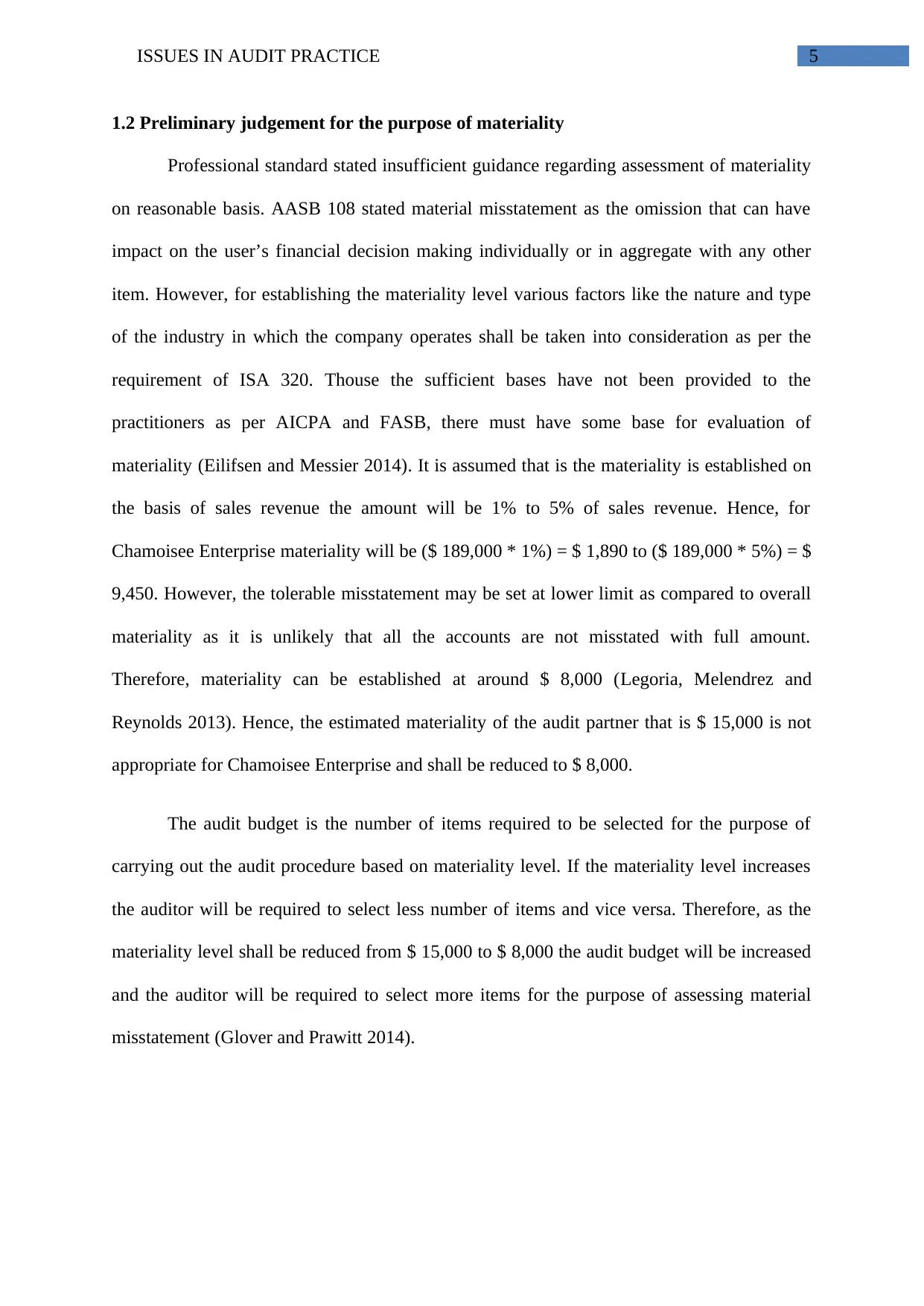
5ISSUES IN AUDIT PRACTICE
1.2 Preliminary judgement for the purpose of materiality
Professional standard stated insufficient guidance regarding assessment of materiality
on reasonable basis. AASB 108 stated material misstatement as the omission that can have
impact on the user’s financial decision making individually or in aggregate with any other
item. However, for establishing the materiality level various factors like the nature and type
of the industry in which the company operates shall be taken into consideration as per the
requirement of ISA 320. Thouse the sufficient bases have not been provided to the
practitioners as per AICPA and FASB, there must have some base for evaluation of
materiality (Eilifsen and Messier 2014). It is assumed that is the materiality is established on
the basis of sales revenue the amount will be 1% to 5% of sales revenue. Hence, for
Chamoisee Enterprise materiality will be ($ 189,000 * 1%) = $ 1,890 to ($ 189,000 * 5%) = $
9,450. However, the tolerable misstatement may be set at lower limit as compared to overall
materiality as it is unlikely that all the accounts are not misstated with full amount.
Therefore, materiality can be established at around $ 8,000 (Legoria, Melendrez and
Reynolds 2013). Hence, the estimated materiality of the audit partner that is $ 15,000 is not
appropriate for Chamoisee Enterprise and shall be reduced to $ 8,000.
The audit budget is the number of items required to be selected for the purpose of
carrying out the audit procedure based on materiality level. If the materiality level increases
the auditor will be required to select less number of items and vice versa. Therefore, as the
materiality level shall be reduced from $ 15,000 to $ 8,000 the audit budget will be increased
and the auditor will be required to select more items for the purpose of assessing material
misstatement (Glover and Prawitt 2014).
1.2 Preliminary judgement for the purpose of materiality
Professional standard stated insufficient guidance regarding assessment of materiality
on reasonable basis. AASB 108 stated material misstatement as the omission that can have
impact on the user’s financial decision making individually or in aggregate with any other
item. However, for establishing the materiality level various factors like the nature and type
of the industry in which the company operates shall be taken into consideration as per the
requirement of ISA 320. Thouse the sufficient bases have not been provided to the
practitioners as per AICPA and FASB, there must have some base for evaluation of
materiality (Eilifsen and Messier 2014). It is assumed that is the materiality is established on
the basis of sales revenue the amount will be 1% to 5% of sales revenue. Hence, for
Chamoisee Enterprise materiality will be ($ 189,000 * 1%) = $ 1,890 to ($ 189,000 * 5%) = $
9,450. However, the tolerable misstatement may be set at lower limit as compared to overall
materiality as it is unlikely that all the accounts are not misstated with full amount.
Therefore, materiality can be established at around $ 8,000 (Legoria, Melendrez and
Reynolds 2013). Hence, the estimated materiality of the audit partner that is $ 15,000 is not
appropriate for Chamoisee Enterprise and shall be reduced to $ 8,000.
The audit budget is the number of items required to be selected for the purpose of
carrying out the audit procedure based on materiality level. If the materiality level increases
the auditor will be required to select less number of items and vice versa. Therefore, as the
materiality level shall be reduced from $ 15,000 to $ 8,000 the audit budget will be increased
and the auditor will be required to select more items for the purpose of assessing material
misstatement (Glover and Prawitt 2014).
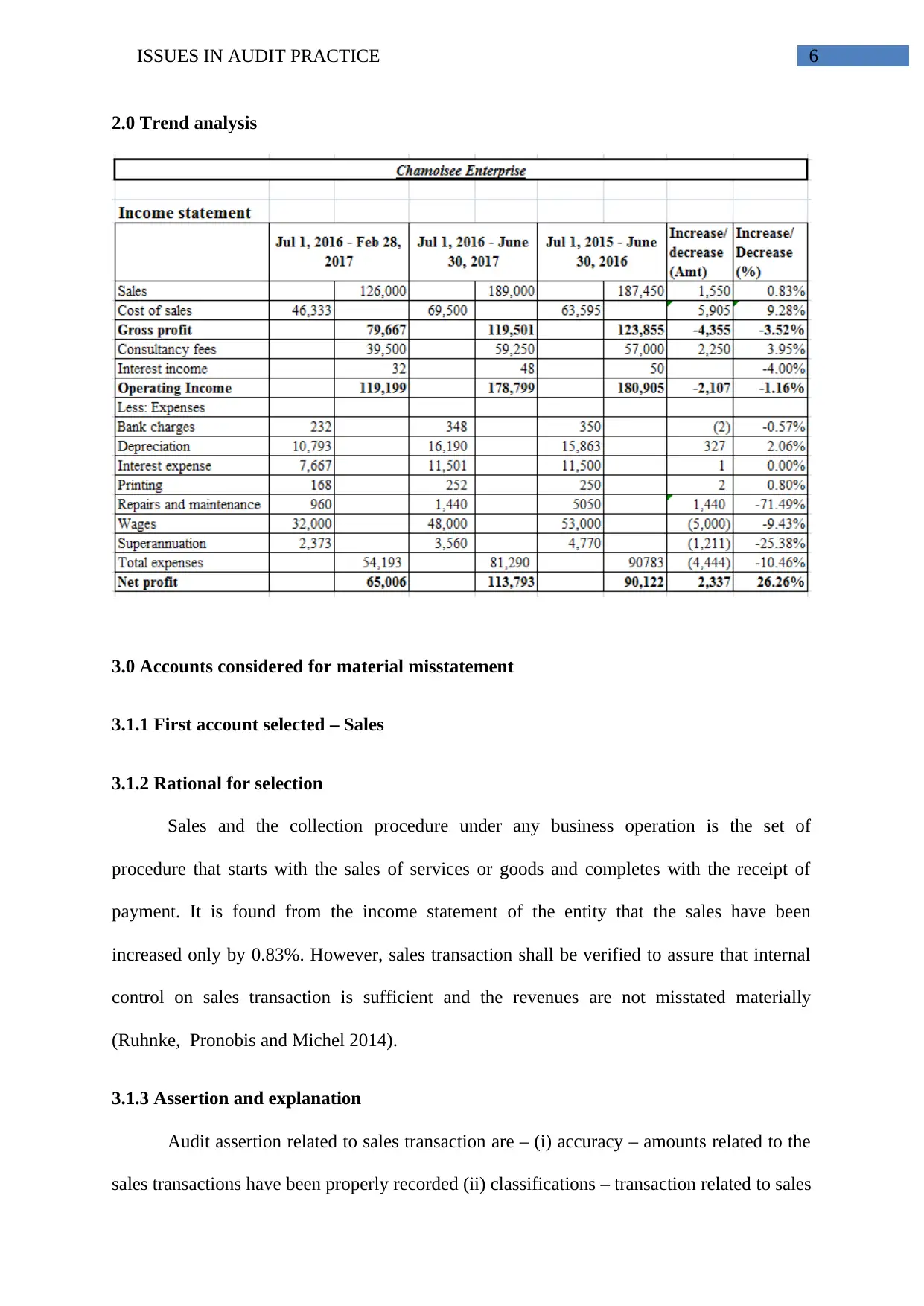
6ISSUES IN AUDIT PRACTICE
2.0 Trend analysis
3.0 Accounts considered for material misstatement
3.1.1 First account selected – Sales
3.1.2 Rational for selection
Sales and the collection procedure under any business operation is the set of
procedure that starts with the sales of services or goods and completes with the receipt of
payment. It is found from the income statement of the entity that the sales have been
increased only by 0.83%. However, sales transaction shall be verified to assure that internal
control on sales transaction is sufficient and the revenues are not misstated materially
(Ruhnke, Pronobis and Michel 2014).
3.1.3 Assertion and explanation
Audit assertion related to sales transaction are – (i) accuracy – amounts related to the
sales transactions have been properly recorded (ii) classifications – transaction related to sales
2.0 Trend analysis
3.0 Accounts considered for material misstatement
3.1.1 First account selected – Sales
3.1.2 Rational for selection
Sales and the collection procedure under any business operation is the set of
procedure that starts with the sales of services or goods and completes with the receipt of
payment. It is found from the income statement of the entity that the sales have been
increased only by 0.83%. However, sales transaction shall be verified to assure that internal
control on sales transaction is sufficient and the revenues are not misstated materially
(Ruhnke, Pronobis and Michel 2014).
3.1.3 Assertion and explanation
Audit assertion related to sales transaction are – (i) accuracy – amounts related to the
sales transactions have been properly recorded (ii) classifications – transaction related to sales
Paraphrase This Document
Need a fresh take? Get an instant paraphrase of this document with our AI Paraphraser
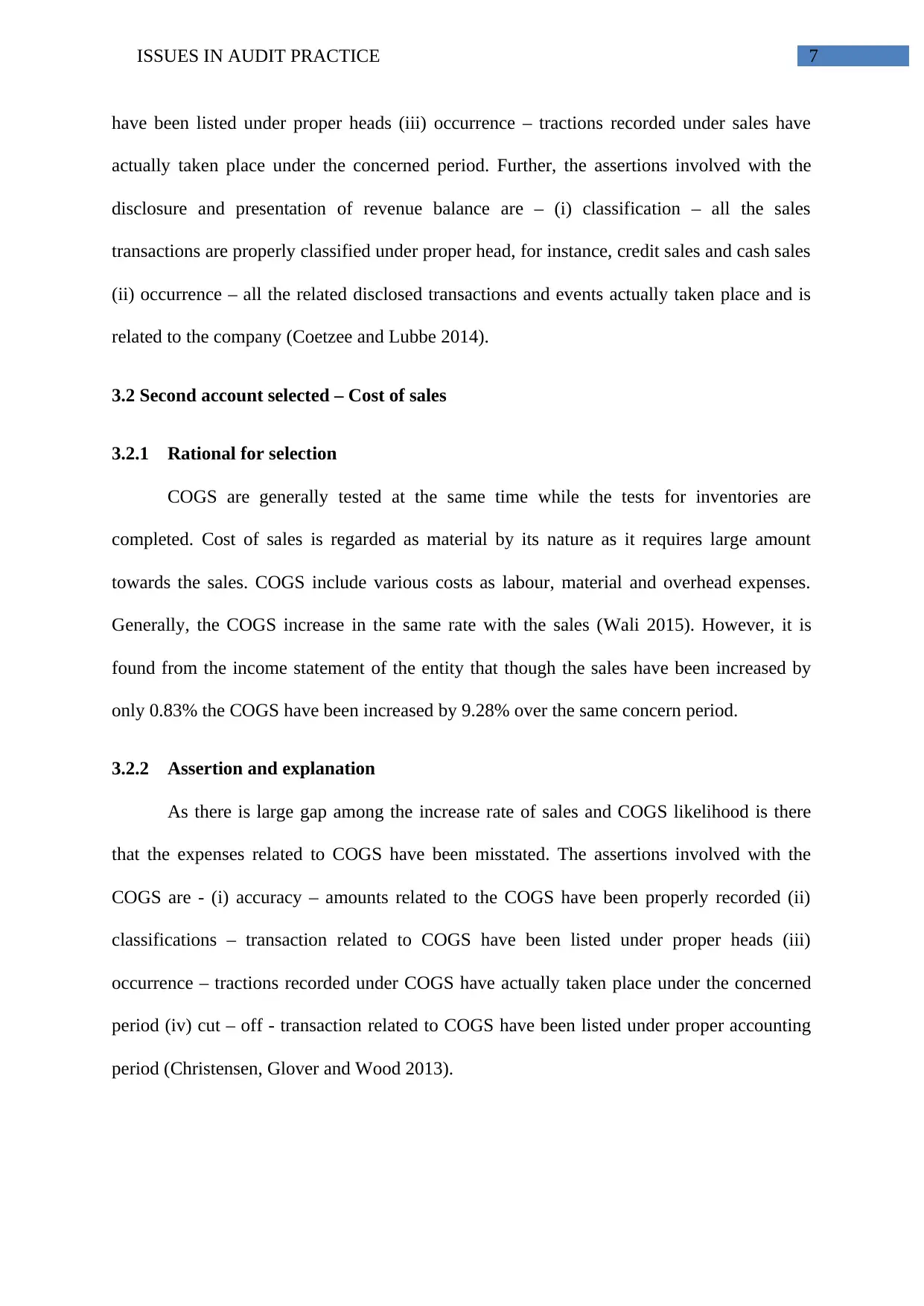
7ISSUES IN AUDIT PRACTICE
have been listed under proper heads (iii) occurrence – tractions recorded under sales have
actually taken place under the concerned period. Further, the assertions involved with the
disclosure and presentation of revenue balance are – (i) classification – all the sales
transactions are properly classified under proper head, for instance, credit sales and cash sales
(ii) occurrence – all the related disclosed transactions and events actually taken place and is
related to the company (Coetzee and Lubbe 2014).
3.2 Second account selected – Cost of sales
3.2.1 Rational for selection
COGS are generally tested at the same time while the tests for inventories are
completed. Cost of sales is regarded as material by its nature as it requires large amount
towards the sales. COGS include various costs as labour, material and overhead expenses.
Generally, the COGS increase in the same rate with the sales (Wali 2015). However, it is
found from the income statement of the entity that though the sales have been increased by
only 0.83% the COGS have been increased by 9.28% over the same concern period.
3.2.2 Assertion and explanation
As there is large gap among the increase rate of sales and COGS likelihood is there
that the expenses related to COGS have been misstated. The assertions involved with the
COGS are - (i) accuracy – amounts related to the COGS have been properly recorded (ii)
classifications – transaction related to COGS have been listed under proper heads (iii)
occurrence – tractions recorded under COGS have actually taken place under the concerned
period (iv) cut – off - transaction related to COGS have been listed under proper accounting
period (Christensen, Glover and Wood 2013).
have been listed under proper heads (iii) occurrence – tractions recorded under sales have
actually taken place under the concerned period. Further, the assertions involved with the
disclosure and presentation of revenue balance are – (i) classification – all the sales
transactions are properly classified under proper head, for instance, credit sales and cash sales
(ii) occurrence – all the related disclosed transactions and events actually taken place and is
related to the company (Coetzee and Lubbe 2014).
3.2 Second account selected – Cost of sales
3.2.1 Rational for selection
COGS are generally tested at the same time while the tests for inventories are
completed. Cost of sales is regarded as material by its nature as it requires large amount
towards the sales. COGS include various costs as labour, material and overhead expenses.
Generally, the COGS increase in the same rate with the sales (Wali 2015). However, it is
found from the income statement of the entity that though the sales have been increased by
only 0.83% the COGS have been increased by 9.28% over the same concern period.
3.2.2 Assertion and explanation
As there is large gap among the increase rate of sales and COGS likelihood is there
that the expenses related to COGS have been misstated. The assertions involved with the
COGS are - (i) accuracy – amounts related to the COGS have been properly recorded (ii)
classifications – transaction related to COGS have been listed under proper heads (iii)
occurrence – tractions recorded under COGS have actually taken place under the concerned
period (iv) cut – off - transaction related to COGS have been listed under proper accounting
period (Christensen, Glover and Wood 2013).
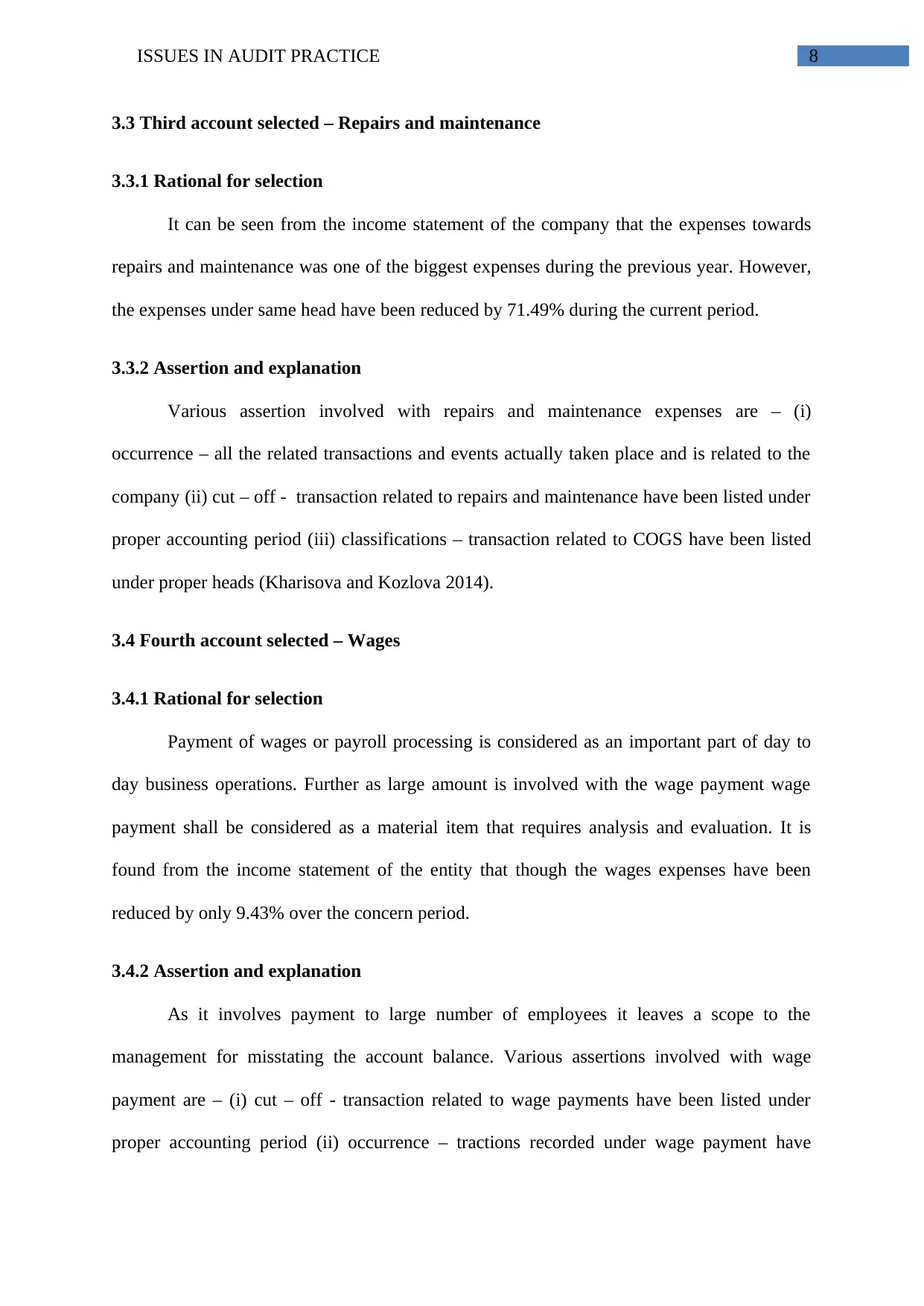
8ISSUES IN AUDIT PRACTICE
3.3 Third account selected – Repairs and maintenance
3.3.1 Rational for selection
It can be seen from the income statement of the company that the expenses towards
repairs and maintenance was one of the biggest expenses during the previous year. However,
the expenses under same head have been reduced by 71.49% during the current period.
3.3.2 Assertion and explanation
Various assertion involved with repairs and maintenance expenses are – (i)
occurrence – all the related transactions and events actually taken place and is related to the
company (ii) cut – off - transaction related to repairs and maintenance have been listed under
proper accounting period (iii) classifications – transaction related to COGS have been listed
under proper heads (Kharisova and Kozlova 2014).
3.4 Fourth account selected – Wages
3.4.1 Rational for selection
Payment of wages or payroll processing is considered as an important part of day to
day business operations. Further as large amount is involved with the wage payment wage
payment shall be considered as a material item that requires analysis and evaluation. It is
found from the income statement of the entity that though the wages expenses have been
reduced by only 9.43% over the concern period.
3.4.2 Assertion and explanation
As it involves payment to large number of employees it leaves a scope to the
management for misstating the account balance. Various assertions involved with wage
payment are – (i) cut – off - transaction related to wage payments have been listed under
proper accounting period (ii) occurrence – tractions recorded under wage payment have
3.3 Third account selected – Repairs and maintenance
3.3.1 Rational for selection
It can be seen from the income statement of the company that the expenses towards
repairs and maintenance was one of the biggest expenses during the previous year. However,
the expenses under same head have been reduced by 71.49% during the current period.
3.3.2 Assertion and explanation
Various assertion involved with repairs and maintenance expenses are – (i)
occurrence – all the related transactions and events actually taken place and is related to the
company (ii) cut – off - transaction related to repairs and maintenance have been listed under
proper accounting period (iii) classifications – transaction related to COGS have been listed
under proper heads (Kharisova and Kozlova 2014).
3.4 Fourth account selected – Wages
3.4.1 Rational for selection
Payment of wages or payroll processing is considered as an important part of day to
day business operations. Further as large amount is involved with the wage payment wage
payment shall be considered as a material item that requires analysis and evaluation. It is
found from the income statement of the entity that though the wages expenses have been
reduced by only 9.43% over the concern period.
3.4.2 Assertion and explanation
As it involves payment to large number of employees it leaves a scope to the
management for misstating the account balance. Various assertions involved with wage
payment are – (i) cut – off - transaction related to wage payments have been listed under
proper accounting period (ii) occurrence – tractions recorded under wage payment have
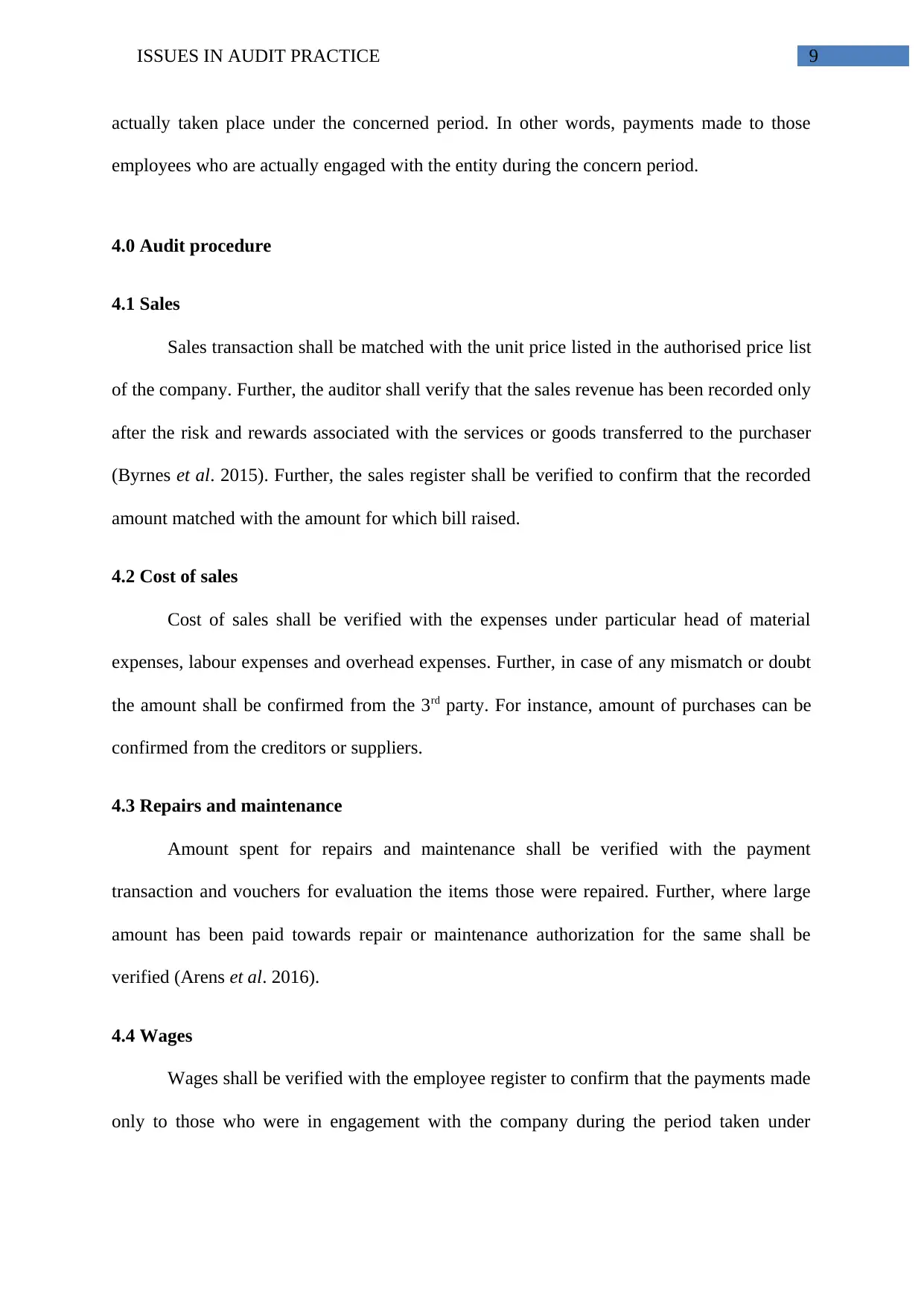
9ISSUES IN AUDIT PRACTICE
actually taken place under the concerned period. In other words, payments made to those
employees who are actually engaged with the entity during the concern period.
4.0 Audit procedure
4.1 Sales
Sales transaction shall be matched with the unit price listed in the authorised price list
of the company. Further, the auditor shall verify that the sales revenue has been recorded only
after the risk and rewards associated with the services or goods transferred to the purchaser
(Byrnes et al. 2015). Further, the sales register shall be verified to confirm that the recorded
amount matched with the amount for which bill raised.
4.2 Cost of sales
Cost of sales shall be verified with the expenses under particular head of material
expenses, labour expenses and overhead expenses. Further, in case of any mismatch or doubt
the amount shall be confirmed from the 3rd party. For instance, amount of purchases can be
confirmed from the creditors or suppliers.
4.3 Repairs and maintenance
Amount spent for repairs and maintenance shall be verified with the payment
transaction and vouchers for evaluation the items those were repaired. Further, where large
amount has been paid towards repair or maintenance authorization for the same shall be
verified (Arens et al. 2016).
4.4 Wages
Wages shall be verified with the employee register to confirm that the payments made
only to those who were in engagement with the company during the period taken under
actually taken place under the concerned period. In other words, payments made to those
employees who are actually engaged with the entity during the concern period.
4.0 Audit procedure
4.1 Sales
Sales transaction shall be matched with the unit price listed in the authorised price list
of the company. Further, the auditor shall verify that the sales revenue has been recorded only
after the risk and rewards associated with the services or goods transferred to the purchaser
(Byrnes et al. 2015). Further, the sales register shall be verified to confirm that the recorded
amount matched with the amount for which bill raised.
4.2 Cost of sales
Cost of sales shall be verified with the expenses under particular head of material
expenses, labour expenses and overhead expenses. Further, in case of any mismatch or doubt
the amount shall be confirmed from the 3rd party. For instance, amount of purchases can be
confirmed from the creditors or suppliers.
4.3 Repairs and maintenance
Amount spent for repairs and maintenance shall be verified with the payment
transaction and vouchers for evaluation the items those were repaired. Further, where large
amount has been paid towards repair or maintenance authorization for the same shall be
verified (Arens et al. 2016).
4.4 Wages
Wages shall be verified with the employee register to confirm that the payments made
only to those who were in engagement with the company during the period taken under
Secure Best Marks with AI Grader
Need help grading? Try our AI Grader for instant feedback on your assignments.

10ISSUES IN AUDIT PRACTICE
consideration. In case of new engagement their contract shall be verified to confirm that they
are getting the same amount that is mentioned in the engagement contract letter.
5.0 Conclusions
It can be concluded from the above that some of the accounts of the company that is
sales, wages, repairs and maintenance and COGS shall be verified for material misstatement.
However, in fraud aspect the auditor is responsible for carrying out the audit to detect the
misstatement due to fraud. It is assumed that the employees or management involved in fraud
if they get chance. Therefore, even if the audit partner is in the view that the employees are
honest they shall be carried out the audit for detecting the fraud misstatement.
consideration. In case of new engagement their contract shall be verified to confirm that they
are getting the same amount that is mentioned in the engagement contract letter.
5.0 Conclusions
It can be concluded from the above that some of the accounts of the company that is
sales, wages, repairs and maintenance and COGS shall be verified for material misstatement.
However, in fraud aspect the auditor is responsible for carrying out the audit to detect the
misstatement due to fraud. It is assumed that the employees or management involved in fraud
if they get chance. Therefore, even if the audit partner is in the view that the employees are
honest they shall be carried out the audit for detecting the fraud misstatement.
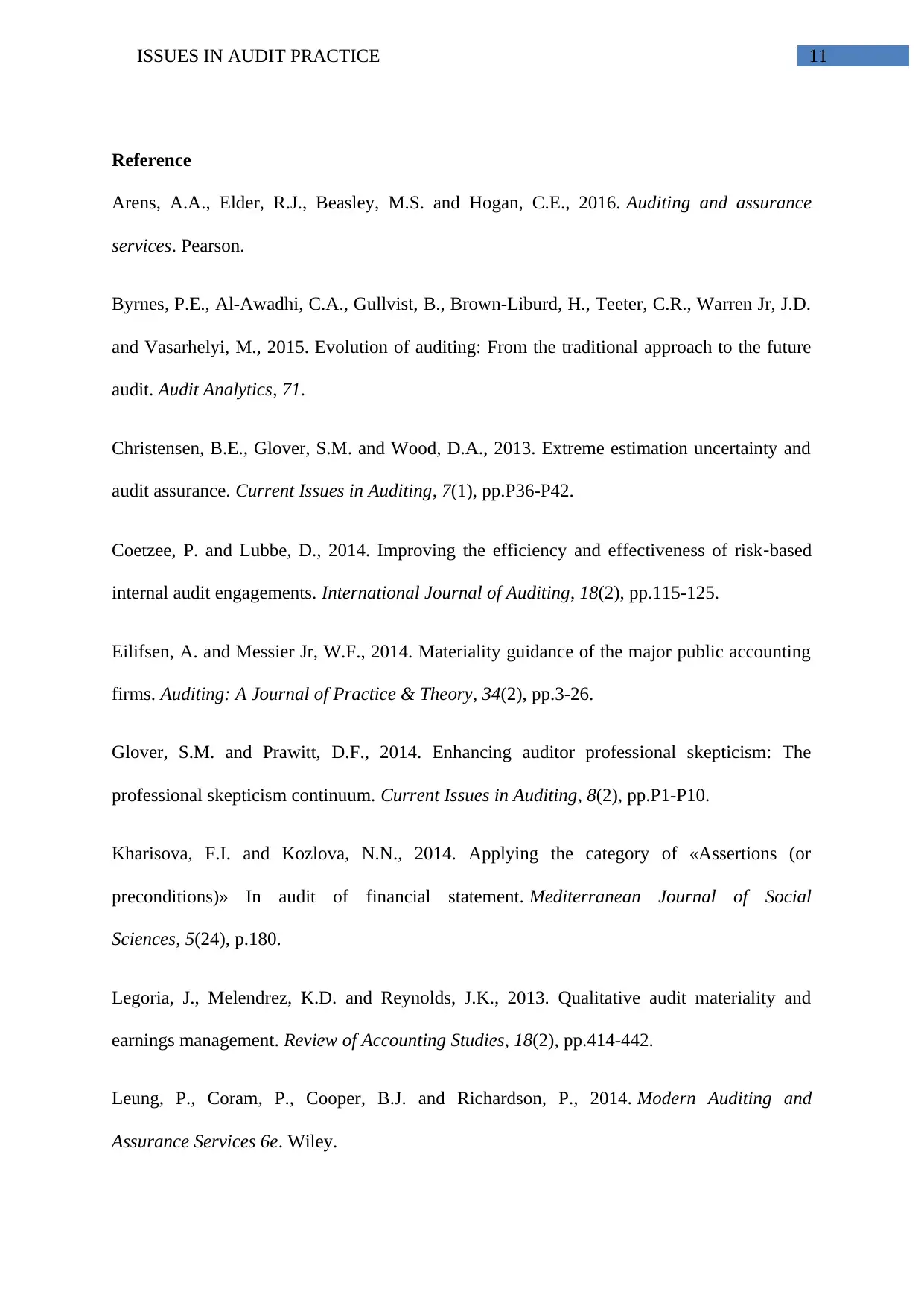
11ISSUES IN AUDIT PRACTICE
Reference
Arens, A.A., Elder, R.J., Beasley, M.S. and Hogan, C.E., 2016. Auditing and assurance
services. Pearson.
Byrnes, P.E., Al-Awadhi, C.A., Gullvist, B., Brown-Liburd, H., Teeter, C.R., Warren Jr, J.D.
and Vasarhelyi, M., 2015. Evolution of auditing: From the traditional approach to the future
audit. Audit Analytics, 71.
Christensen, B.E., Glover, S.M. and Wood, D.A., 2013. Extreme estimation uncertainty and
audit assurance. Current Issues in Auditing, 7(1), pp.P36-P42.
Coetzee, P. and Lubbe, D., 2014. Improving the efficiency and effectiveness of risk‐based
internal audit engagements. International Journal of Auditing, 18(2), pp.115-125.
Eilifsen, A. and Messier Jr, W.F., 2014. Materiality guidance of the major public accounting
firms. Auditing: A Journal of Practice & Theory, 34(2), pp.3-26.
Glover, S.M. and Prawitt, D.F., 2014. Enhancing auditor professional skepticism: The
professional skepticism continuum. Current Issues in Auditing, 8(2), pp.P1-P10.
Kharisova, F.I. and Kozlova, N.N., 2014. Applying the category of «Assertions (or
preconditions)» In audit of financial statement. Mediterranean Journal of Social
Sciences, 5(24), p.180.
Legoria, J., Melendrez, K.D. and Reynolds, J.K., 2013. Qualitative audit materiality and
earnings management. Review of Accounting Studies, 18(2), pp.414-442.
Leung, P., Coram, P., Cooper, B.J. and Richardson, P., 2014. Modern Auditing and
Assurance Services 6e. Wiley.
Reference
Arens, A.A., Elder, R.J., Beasley, M.S. and Hogan, C.E., 2016. Auditing and assurance
services. Pearson.
Byrnes, P.E., Al-Awadhi, C.A., Gullvist, B., Brown-Liburd, H., Teeter, C.R., Warren Jr, J.D.
and Vasarhelyi, M., 2015. Evolution of auditing: From the traditional approach to the future
audit. Audit Analytics, 71.
Christensen, B.E., Glover, S.M. and Wood, D.A., 2013. Extreme estimation uncertainty and
audit assurance. Current Issues in Auditing, 7(1), pp.P36-P42.
Coetzee, P. and Lubbe, D., 2014. Improving the efficiency and effectiveness of risk‐based
internal audit engagements. International Journal of Auditing, 18(2), pp.115-125.
Eilifsen, A. and Messier Jr, W.F., 2014. Materiality guidance of the major public accounting
firms. Auditing: A Journal of Practice & Theory, 34(2), pp.3-26.
Glover, S.M. and Prawitt, D.F., 2014. Enhancing auditor professional skepticism: The
professional skepticism continuum. Current Issues in Auditing, 8(2), pp.P1-P10.
Kharisova, F.I. and Kozlova, N.N., 2014. Applying the category of «Assertions (or
preconditions)» In audit of financial statement. Mediterranean Journal of Social
Sciences, 5(24), p.180.
Legoria, J., Melendrez, K.D. and Reynolds, J.K., 2013. Qualitative audit materiality and
earnings management. Review of Accounting Studies, 18(2), pp.414-442.
Leung, P., Coram, P., Cooper, B.J. and Richardson, P., 2014. Modern Auditing and
Assurance Services 6e. Wiley.

12ISSUES IN AUDIT PRACTICE
Louwers, T.J., Ramsay, R.J., Sinason, D.H., Strawser, J.R. and Thibodeau, J.C., 2015.
Auditing & assurance services. McGraw-Hill Education.
Ruhnke, K., Pronobis, P. and Michel, M., 2014. Audit materiality disclosures and credit
lending decisions.
Titera, W.R., 2013. Updating audit standard—Enabling audit data analysis. Journal of
Information Systems, 27(1), pp.325-331.
Wali, S., 2015. Mechanisms of corporate governance and fixed asset
revaluation. International Journal of Accounting and Finance, 5(1), pp.82-97.
Louwers, T.J., Ramsay, R.J., Sinason, D.H., Strawser, J.R. and Thibodeau, J.C., 2015.
Auditing & assurance services. McGraw-Hill Education.
Ruhnke, K., Pronobis, P. and Michel, M., 2014. Audit materiality disclosures and credit
lending decisions.
Titera, W.R., 2013. Updating audit standard—Enabling audit data analysis. Journal of
Information Systems, 27(1), pp.325-331.
Wali, S., 2015. Mechanisms of corporate governance and fixed asset
revaluation. International Journal of Accounting and Finance, 5(1), pp.82-97.
1 out of 13
Related Documents
Your All-in-One AI-Powered Toolkit for Academic Success.
+13062052269
info@desklib.com
Available 24*7 on WhatsApp / Email
![[object Object]](/_next/static/media/star-bottom.7253800d.svg)
Unlock your academic potential
© 2024 | Zucol Services PVT LTD | All rights reserved.

